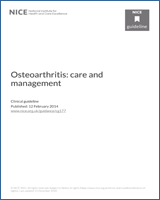NCBI Bookshelf. A service of the National Library of Medicine, National Institutes of Health.
Update information: December 2020: in the recommendation on adding opioid analgesics NICE added links to other NICE guidelines and resources that support discussion with patients about opioid prescribing and safe withdrawal management. For the current recommendations, see www.nice.org.uk/guidance/CG177/chapter/recommendations.
Excerpt
Osteoarthritis refers to a clinical syndrome of joint pain accompanied by varying degrees of functional limitation and reduced quality of life. It is the most common form of arthritis, and one of the leading causes of pain and disability worldwide. The most commonly affected peripheral joints are the knees, hips and small hand joints. Although pain, reduced function and effects on a person’s ability to carry out their day-to-day activities can be important consequences of osteoarthritis, pain in itself is of course a complex biopsychosocial issue, related in part to person expectations and self-efficacy, and associated with changes in mood, sleep and coping abilities. There is often a poor link between changes on an X-ray and symptoms: minimal changes can be associated with a lot of pain and modest structural changes to joints oftencan occur without with minimal accompanying symptoms. Contrary to popular belief, osteoarthritis is not caused by ageing and does not necessarily deteriorate. There are a number of management and treatment options (both pharmacological and non-pharmacological), which this guideline addresses and which offer effective interventions for control of symptoms and improving function.
Osteoarthritis is characterised pathologically by localised loss of cartilage, remodelling of adjacent bone and associated inflammation. A variety of traumas may trigger the need for a joint to repair itself. Osteoarthritis includes a slow but efficient repair process that often compensates for the initial trauma, resulting in a structurally altered but symptom-free joint. In some people, because of either overwhelming trauma or compromised repair, the process cannot compensate, resulting in eventual presentation with symptomatic osteoarthritis; this might be thought of as ‘joint failure’. This in part explains the extreme variability in clinical presentation and outcome that can be observed between people, and also at different joints in the same person.
There are limitations to the published evidence on treating osteoarthritis. Most studies have focused on knee osteoarthritis, and are often of short duration using single therapies. Although most trials have looked at single joint involvement, in reality many people have pain in more than one joint, which may alter the effectiveness of interventions.
This guideline update was originally intended to include recommendations based on a review of new evidence about the use of paracetamol, etoricoxib and fixed-dose combinations of NSAIDs plus gastroprotective agents in the management of osteoarthritis. Draft recommendations based on the evidence reviews for these areas were presented in the consultation version of the guideline. Stakeholder feedback at consultation indicated that the draft recommendations, particularly in relation to paracetamol, would be of limited clinical application without a full review of evidence on the pharmacological management of osteoarthritis. NICE was also aware of an ongoing review by the MHRA of the safety of over-the-counter analgesics. Therefore NICE intends to commission a full review of evidence on the pharmacological management of osteoarthritis, which will start once the MHRA’s review is completed, to inform a further guideline update.
Until that update is published, the original recommendations (from 2008) on the pharmacological management of osteoarthritis remain current advice. However, the GDG would like to draw attention to the findings of the evidence review on the effectiveness of paracetamol that was presented in the consultation version of the guideline. That review identified reduced effectiveness of paracetamol in the management of osteoarthritis compared with what was previously thought. The GDG believes that this information should be taken into account in routine prescribing practice until the intended full review of evidence on the pharmacological management of osteoarthritis is published (see the NICE website for further details).
Contents
- Guideline development group members
- Acknowledgements
- 1. Introduction
- 2. Development of the guideline
- 3. Methods
- 4. Guideline summary
- 5. Diagnosis
- 6. Holistic approach to osteoarthritis assessment and management
- 7. Education and self-management
- 8. Non-pharmacological management of osteoarthritis
- 9. Pharmacological management of osteoarthritis
- 10. Intra-articular Injections
- 11. Referral for specialist services
- 12. Consideration of timing for surgery
- 13. Patient follow-up
- 14. Reference list
- 15. Glossary
- Appendices
- Appendix A. Scope
- Appendix B. Declarations of interest
- Appendix C. Review protocols
- Appendix D. Clinical article selection
- Appendix E. Economic article selection
- Appendix F. Literature search strategies
- Appendix G. Clinical Evidence tables
- Appendix H. Economic evidence tables
- Appendix I. Forest plots
- Appendix J. Excluded clinical studies
- Appendix K. Excluded economic studies
- Appendix L. Cost-effectiveness of oral analgesics (paracetamol/NSAIDs/COX-2 inhibitors) for Osteoarthritis (CG59)
- Appendix M. CG59 cost consequences analysis
- Appendix N. Research recommendations
- Appendix O. Working diagnosis and methods from CG59
- Appendix P. Deleted sections from CG59
- Appendix Q. Recommendations from NICE clinical guideline 59 (2008) that have been deleted or changed
- Appendix R. CG59 clinical evidence tables
- Appendix S. Reference List
Disclaimer: Healthcare professionals are expected to take NICE clinical guidelines fully into account when exercising their clinical judgement. However, the guidance does not override the responsibility of healthcare professionals to make decisions appropriate to the circumstances of each patient, in consultation with the patient and/or their guardian or carer.

